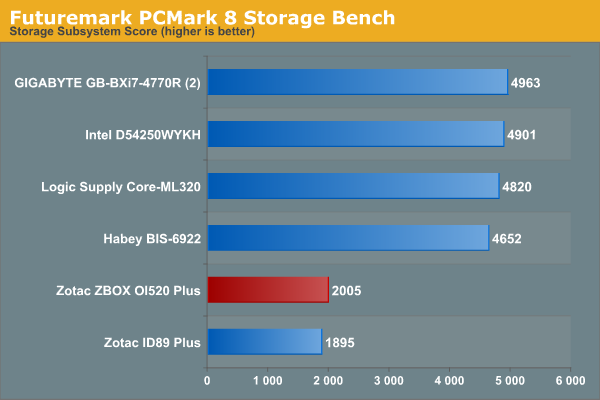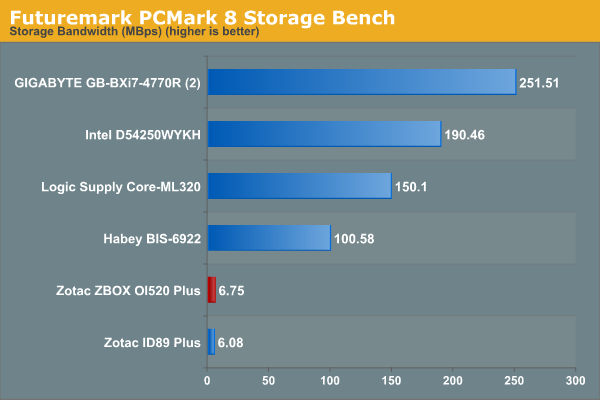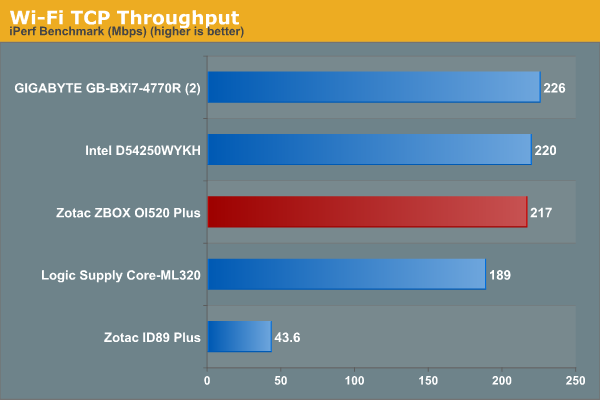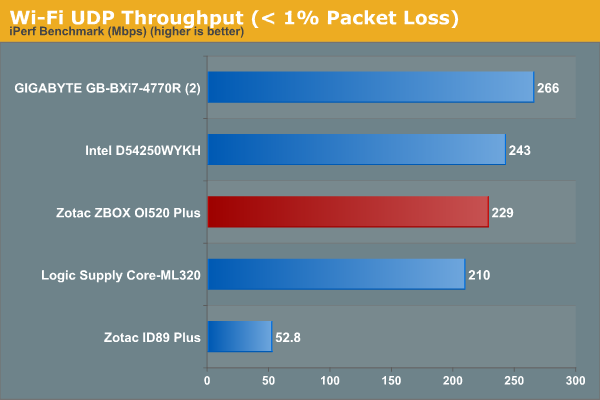ZBOX Sphere OI520 Plus: Zotac's Take on the NUC
by Ganesh T S on August 1, 2014 8:50 AM ESTStorage and Wireless Networking Credentials
We have recently started devoting a separate section to analyze the storage and networking credentials of the units under review. On the storage side, one option would be repetition of our strenuous SSD review tests on the drive(s) in the PC. Fortunately, to avoid that overkill, PCMark 8 has a storage bench where certain common workloads such as loading games and document processing are replayed on the target drive. Results are presented in two forms, one being a benchmark number and the other, a bandwidth figure. We ran the PCMark 8 storage bench on selected PCs and the results are presented below.


The OI520 Plus obviously suffers here due to the absence of a SSD.
On the networking side, we restricted ourselves to the evaluation of the WLAN component. Our standard test router is the Netgear R7000 Nighthawk configured with both 2.4 GHz and 5 GHz networks. The router is placed approximately 20 ft. away, separated by a drywall (as in a typical US building). A wired client (Zotac ID89-Plus) is connected to the R7000 and serves as one endpoint for iPerf evaluation. The PC under test is made to connect to either the 5 GHz (preferred) or 2.4 GHz SSID and iPerf tests are conducted for both TCP and UDP transfers. It is ensured that the PC under test is the only wireless client for the Netgear R7000. We evaluate total throughput for up to 32 simultaneous TCP connections using iPerf and present the highest number in the graph below.

In the UDP case, we try to transfer data at the highest rate possible for which we get less than 1% packet loss.

The wireless card performs as well as the 2x2 Intel AC card in the NUC, despite being 1x1 only










40 Comments
View All Comments
Sushisamurai - Friday, August 1, 2014 - link
It would almost seem like a 65W Kaveri would have been a better fit in this system... Especially considering local file playbackSushisamurai - Friday, August 1, 2014 - link
Oops, didn't notice this was a 15W watt part... Kaveri doesn't really fit then... Or does it ^_~BMNify - Friday, August 1, 2014 - link
no amd soc meets these soc as AVX2 and Intel® Quick Sync Video are pretty much a base requirement in 2014/15 for high quality video playback and real time video capture/streaming.BMNify - Friday, August 1, 2014 - link
OC saying that , even this dual core/quad thread intel soc doesn't really cut it for me, i cant even remember the last dual core anything i bought, even with intel in 2014/15 even if the OEM's are buying loads of intel soc for the next mobile/static blitz this holiday season , im not interested in buying as an end consumer unless its got quad core, and the said AVX2+ and Quick Sync...Assimilator87 - Friday, August 1, 2014 - link
<blockquote>no amd soc meets these soc as AVX2 and Intel® Quick Sync Video are pretty much a base requirement in 2014/15 for high quality video playback and real time video capture/streaming.</blockquote>BMNify, I'm not arguing against your love for AVX2 and Quick Sync. On the other hand, you've overlooked some details. Haswell is not an SoC. That honor belongs to the Saltwell based chips. Also, both AMD and nVidia have equivalents to Quick Sync, being VCE and NVENC respectively.
xdrol - Sunday, August 3, 2014 - link
Mobile Haswell _is_ an SoC.But AVX2 as base requirement? lol.. there are practically no programs for AVX2 because Intel decided to leave it out 70+% of all sold devices (Celerons, Pentiums). And QuickSync as "high quiality"? Have you even seen what blurry shit it makes?
emn13 - Sunday, August 3, 2014 - link
That's just nonsense. You certainly don't need quicksync for even high-end video playback - a single CPU tends to be enough (and you've got more than one, right?). I suspect AMD has a "iGPU" accelerated playback mode too. Though again, you don't need it (and the quality of quicksync is inferior to that of software decoders/encoders).AVX2 is neat, but similar truly not a requirement.
I recently got smoothvideo to run... smoothly on an ancient Q6600 with an ancient 9600GT card. I would certainly recommend more, but note: you really don't need quicksync.
Flunk - Friday, August 1, 2014 - link
Gigabyte build a Brix based on AMD's last-gen Richland core. Now that a 45watt Kaveri chip is available they may decide to build one with that.For perspective the i7-4770R in the Brix Pro, which is both larger and runs hot is a 65watt chip so I can't see zotac fitting it in here.
nathanddrews - Friday, August 1, 2014 - link
I was going to say "wait for Carrizo", but that will likely be a 28nm part (at this rate), so I don't think they'll get their power/heat issues resolved. I like these little systems, but they are all just too weak in GPU power to justify moving away from my current setups.Sushisamurai - Friday, August 1, 2014 - link
Yeah, little systems attract me too. But I agree with subpar GPU performance. I still remember my netbook struggling to run a 1080p mkv file... *sighs*